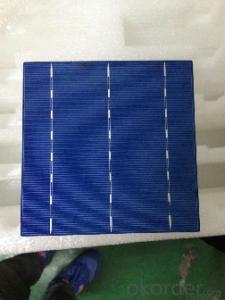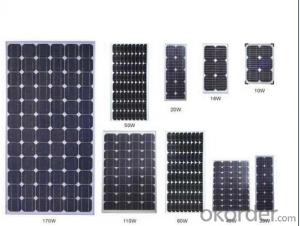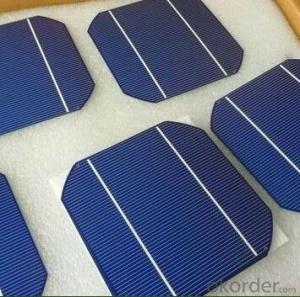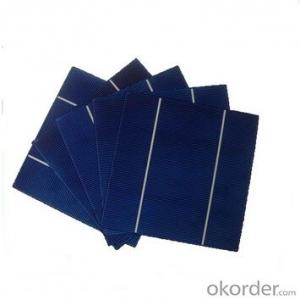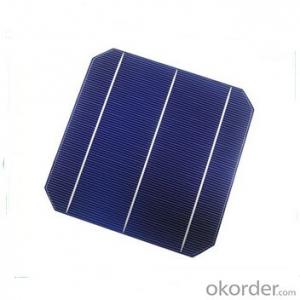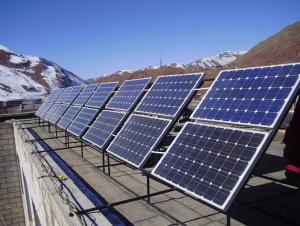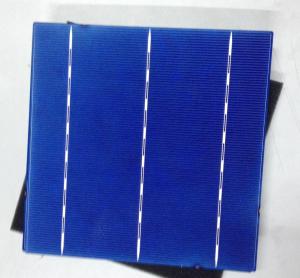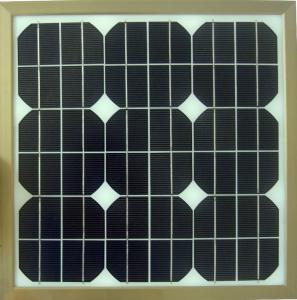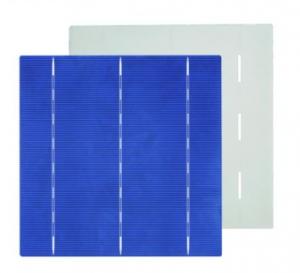Mini Solar Cells - High Quality Monocrystalline Solar Cells 17.70-17.90
- Loading Port:
- Shanghai
- Payment Terms:
- TT OR LC
- Min Order Qty:
- 1000 pc
- Supply Capability:
- 1000000 pc/month
OKorder Service Pledge
OKorder Financial Service
You Might Also Like
Solar Cells:
Solar cells is made by solar wafer, it has three categories of solar cell right now, monocrystalline polycrystalline and thin film,These cells are entirely based around the concept PN junction, which is the critical part of solar module, it is the part that can convert the light energy into electricity, the thickness is from 180um to 200um, with even busbars to conduct electricity, textured cell can decrease diffuse reflection; they are often electrically connected and encapsulated as a module. Photovoltaic modules often have a sheet of glass on the front (sun up) side, allowing light to pass while protecting semiconductor wafers from abrasion and impact due to wind-driven debris, rain, hail, etc. Solar cells are also usually connected in series in modules, creating an additive voltage. Connecting cells in parallel will yield a higher current;With high quality and stable quality. Our Cells can greatly improve the performance of Solar Modules.
Features:
1. High conversion efficiencies resulting in superior power output performance.
2. Outstanding power output even in low light or high temperature conditions
3. Optimized design for ease of soldering and lamination
4. Long-term stability, reliability and performance
5. Low breakage rate
6. Color uniformity
Solar Cells Advantage:
• High efficiency and stable performance in photovoltaic conversion.
• Advanced diffusion technique ensuring the homogeneity of energy conversion efficiency of the cell.
• Advanced PECVD film forming, providing a dark blue silicon nitride anti-reflection film of homogenous color and attractive appearance.
• High quality metal paste for back surface and electrode, ensuring good conductivity, high pulling strength and ease of soldering.
• High precision patterning using screen printing, ensuring accurate busbar location for ease with automatic soldering a laser cutting.
Specifications:
Efficiency | Efficiency | Pmax(W) | Average | Impp(A) | Vmpp(V) | Isc(A) | Voc(V) |
1840 | 18.30-18.50 | >4.371 | >4.371 | 8.285 | 0.530 | 8.695 | 0.626 |
1820 | 18.10-18.30 | 4.323-4.371 | 4.347 | 8.245 | 0.528 | 8.662 | 0.626 |
1800 | 17.90-18.10 | 4.276-4.323 | 4.299 | 8.190 | 0.526 | 8.630 | 0.625 |
1780 | 17.70-17.90 | 4.228-4.276 | 4.252 | 8.140 | 0.524 | 8.621 | 0.624 |
1760 | 17.50-17.70 | 4.180-4.228 | 4.204 | 8.095 | 0.522 | 8.598 | 0.623 |
1740 | 17.30-17.50 | 4.132-4.180 | 4.156 | 8.045 | 0.520 | 8.568 | 0.622 |
1720 | 17.10-17.30 | 4.085-4.132 | 4.108 | 7.905 | 0.518 | 8.528 | 0.620 |
Packaging & Delivery of Solar Cells
Carton Box Package and Deliver by air. It should be noticed that it should be avoid of water, sunshine and moist.
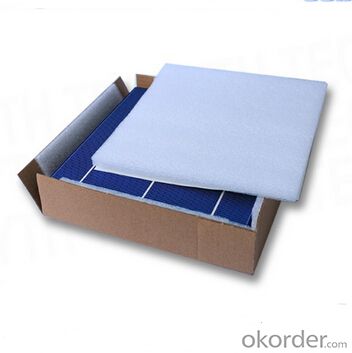
FAQ
We have organized several common questions for our clients,may help you sincerely:
①What price for each watt?
It depends on the efficiency of the solar cell, quantity, delivery date and payment terms.
②How long can we receive the product after purchase?
In the purchase of product within three working days, We will arrange the factory delivery as soon as possible. The pecific time of receiving is related to the state and position of customers.Commonly 7 to 10 working days can be served.
③Can you provide the peripheral products of the solar panels, such as the battery, controller, and inverter? If so, can you tell me how do they match each other?
Yes, we can, we have two companies for solar region, one is CNBM International, the other is CNBM engineering Co.
We can provide you not only the solar module but also the off grid solar system, we can also provide you service with on grid plant.
④What is your warranty of solar cell?
Our product can promise lower than 0.3% open box crack, we support claim after opening the box if it has crackm color difference or sth, the buyer should give pictures immediately, we can not accept the claim after the solar cell has assembled to solar panel.
• Timeliness of delivery
• ⑤How do you pack your products?
We have rich experience on how to pack the solar cell to make sure the safety on shipment, we could use wooden box or pallet as buyer's preference.
- Q: Can solar cells be used in indoor lighting applications?
- Yes, solar cells can be used in indoor lighting applications. However, since solar cells require sunlight to generate electricity, they may not be as efficient in indoor settings where natural light is limited. Additionally, the amount of energy generated may not be sufficient for high-powered indoor lighting, making solar cells more suitable for low-power applications or as supplemental lighting sources.
- Q: How do solar cells perform in regions with high levels of air pollution?
- Solar cells perform less efficiently in regions with high levels of air pollution. Air pollution can block sunlight and reduce the amount of solar radiation reaching the solar cells, which in turn decreases their power output. Additionally, pollutants in the air can accumulate on the surface of solar panels, forming a layer of grime that further reduces their performance. Regular cleaning and maintenance of solar panels are necessary in such regions to ensure optimal functioning.
- Q: What is the role of combiners in solar cell systems?
- The role of combiners in solar cell systems is to combine or merge the electrical outputs from multiple solar panels into a single output. This allows for increased efficiency and power generation by effectively utilizing the energy produced by each individual panel.
- Q: What is the role of solar cells in powering traffic signals?
- Solar cells play a crucial role in powering traffic signals by harnessing sunlight and converting it into electrical energy. This renewable energy source eliminates the need for traditional grid connection and reduces the environmental impact of traffic signals. Solar cells ensure a sustainable and reliable power supply for traffic signals, even during power outages, while simultaneously reducing energy costs and promoting a greener transportation infrastructure.
- Q: Can solar cells be used for desalination?
- Yes, solar cells can be used for desalination. Solar energy can be harnessed by solar cells to power desalination plants that convert seawater or brackish water into freshwater through processes like reverse osmosis or multi-stage flash distillation. This sustainable approach reduces reliance on traditional energy sources and offers a potential solution to address the global water scarcity issue.
- Q: Can solar cells be used for outdoor signage?
- Yes, solar cells can be used for outdoor signage. Solar cells are capable of converting sunlight into electricity, which can power the lighting or display systems used in outdoor signage. This allows for an environmentally-friendly and cost-effective solution for outdoor signage, as it eliminates the need for traditional power sources and reduces energy consumption.
- Q: How do solar cells impact national energy policies?
- Solar cells have a significant impact on national energy policies as they promote renewable energy and reduce reliance on fossil fuels. Governments often incentivize the adoption of solar cells through policies such as tax credits, feed-in tariffs, and net metering, which encourage their installation and use. This helps diversify the energy mix, reduce greenhouse gas emissions, and enhance energy security, ultimately leading to a more sustainable and resilient national energy system.
- Q: How do solar cells perform in areas with high humidity and saltwater exposure?
- Solar cells generally perform well in areas with high humidity and saltwater exposure. However, prolonged exposure to high humidity and saltwater can potentially degrade the performance and lifespan of solar cells. The humidity can cause moisture to accumulate on the surface of the solar panels, leading to reduced efficiency. Additionally, saltwater exposure can corrode the metal components of the solar cells, further impacting their performance. To mitigate these issues, manufacturers often use corrosion-resistant materials and coatings for solar panels deployed in coastal regions or areas with high humidity. Regular maintenance and cleaning can also help ensure optimal performance in such environments.
- Q: How do solar cells handle power fluctuations?
- Solar cells handle power fluctuations through a process called maximum power point tracking (MPPT), which optimizes the output power of the cell. MPPT algorithms continuously monitor the voltage and current of the solar cell and adjust the load resistance to ensure that the cell operates at its maximum power point, even in the presence of fluctuations in solar irradiance or temperature. This allows solar cells to efficiently convert sunlight into electricity and adapt to changing environmental conditions.
- Q: Can solar cells be used for hydrogen production?
- Yes, solar cells can be used for hydrogen production through a process called photoelectrochemical water splitting. This involves using the energy from sunlight to split water molecules into hydrogen and oxygen gases, with the hydrogen gas being stored for later use as an energy source.
Send your message to us
Mini Solar Cells - High Quality Monocrystalline Solar Cells 17.70-17.90
- Loading Port:
- Shanghai
- Payment Terms:
- TT OR LC
- Min Order Qty:
- 1000 pc
- Supply Capability:
- 1000000 pc/month
OKorder Service Pledge
OKorder Financial Service
Similar products
Hot products
Hot Searches
Related keywords










